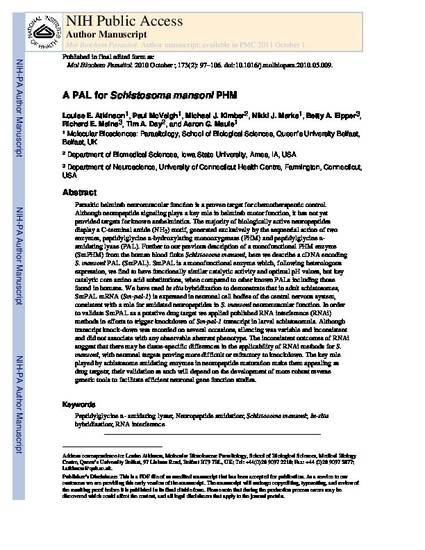
Parasitic helminth neuromuscular function is a proven target for chemotherapeutic control. Although neuropeptide signalling plays a key role in helminth motor function, it has not yet provided targets for known anthelmintics. The majority of biologically active neuropeptides display a C-terminal amide (NH2) motif, generated exclusively by the sequential action of two enzymes, peptidylglycine α-hydroxylating monooxygenase (PHM) and peptidylglycine α-amidating lyase (PAL). Further to our previous description of a monofunctional PHM enzyme (SmPHM) from the human blood fluke Schistosoma mansoni, here we describe a cDNA encoding S. mansoni PAL (SmPAL). SmPAL is a monofunctional enzyme which, following heterologous expression, we find to have functionally similar catalytic activity and optimal pH values, but key catalytic core amino acid substitutions, when compared to other known PALs including those found in humans. We have used in situ hybridisation to demonstrate that in adult schistosomes, SmPAL mRNA (Sm-pal-1) is expressed in neuronal cell bodies of the central nervous system, consistent with a role for amidated neuropeptides in S. mansoni neuromuscular function. In order to validate SmPAL as a putative drug target we applied published RNA interference (RNAi) methods in efforts to trigger knockdown of Sm-pal-1 transcript in larval schistosomula. Although transcript knockdown was recorded on several occasions, silencing was variable and inconsistent and did not associate with any observable aberrant phenotype. The inconsistent outcomes of RNAi suggest that there may be tissue-specific differences in the applicability of RNAi methods for S. mansoni, with neuronal targets proving more difficult or refractory to knockdown. The key role played by schistosome amidating enzymes in neuropeptide maturation make them appealing as drug targets; their validation as such will depend on the development of more robust reverse genetic tools to facilitate efficient neuronal gene function studies.
Available at: http://works.bepress.com/michael-kimber/20/

This article is from Molecular and Biochemical Parasitology 173 (2010): 97–106, doi:10.1016/j.molbiopara.2010.05.009. Posted with permission.